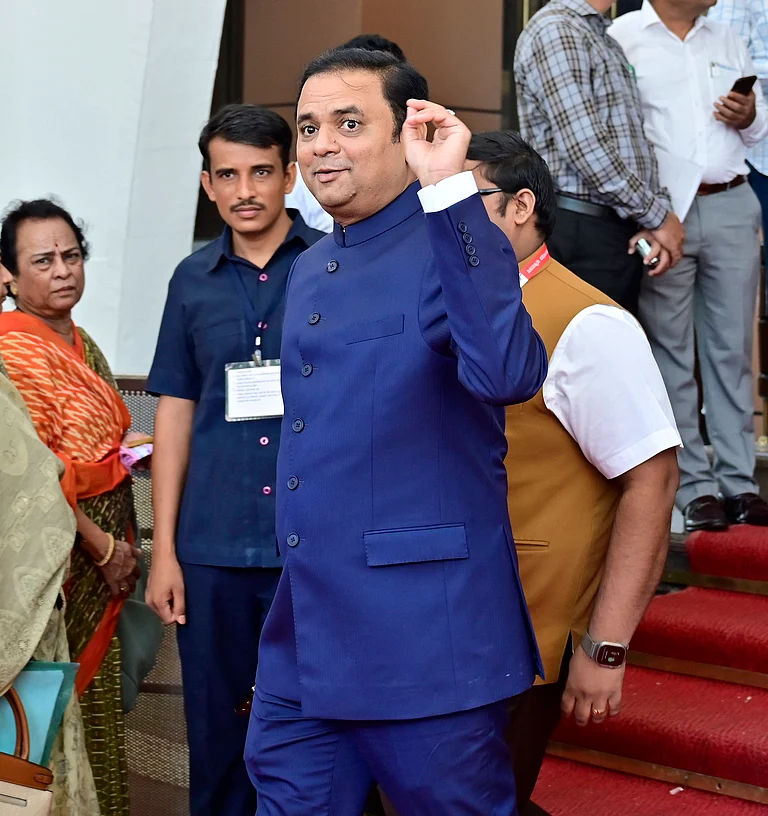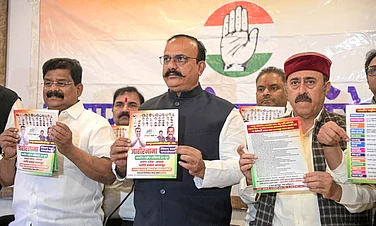Across the textile map of India, rarely does one find a weave being worn by only a particular caste, tribe or religion. I know of none, other than the checked kapodd, the traditional attire of the Catholic Gawda women of Goa.
The Gawdas are the original inhabitants of Goa. Primarily engaged in agriculture, they were originally nature worshippers, but took to Hindu practices over the past millennium. A section of the Gawda population in several villages of South Goa got converted to Catholicism around the 17th century during Portuguese rule. It is the women of this community who wear the brightly coloured checked kapodds. The origin of this weave is unknown and there are no records of another caste or community wearing this kapodd, not even the Hindu Gawdas. So, it may be assumed that sometime after conversion the community women adopted the attire.
ALSO READ: Tears Of The Mermaid: The Melancholy Of Goa
The kapodd has a checked body and is woven in hues of red. The border, being its signature feature, is made of a darker colour with two rows of rudraksh (stone fruit) motifs. The Catholic Church practiced the use of dark colours during mourning. Hence, widows wear indigo-based bluish purple kapodds. The native sensibilities did not support the use of black colour, and it is believed that the black kapodd was woven only in the past few decades.
The draping of the kapodd too differs from their Hindu sisters. The Hindu women wear a nine-yard sari with a pleat tucked in between their legs called the kas. The end of the sari is tied in a knot on the right shoulder called the dettli, which holds the sari firmly across the chest as in the past they did not wear a stitched blouse to cover the upper body. The blouse was introduced later during Portuguese rule. In comparison to this, the Christian Gawda women wear a six-yard sari just encircled around the body without the kas, which they drape a little higher than their ankles. However, the dettli is tied in the same manner on the right shoulder. One end of the drape is tucked into the waist to form a pocket called vhot to secure small objects. This drape ensures comfort and hands-free movement as the women toil in the fields in the warm, sultry weather of Goa.
Weaving was an established industry in Goa by the 20th century. It is hard to say when weaving began, but by the mid-20th century, a number of weaving clusters operated in various villages of North Goa, like Sinquerim, Nerul, Candolim and Bastora. The Gawdas themselves never wove the kappod as is commonly understood. Besides a couple of Goan families who practiced weaving, the rest were immigrants from neighbouring Karnataka. They wove towels, loincloths and the Gawda kapodd.
Kapodds were retailed only in a particular family-run cloth store in the market in Margao, the commercial capital of South Goa. The Gawdas have displayed a vibrant cultural identity in which the kapodd has played an integral part. Rich traditions of music and dance around a flower-bedecked lamp to the beats of the dhol, tashe and ghumott (musical instruments) in a sacred space called the mandd have been the mainstay of their customs. Many of the songs sung on the mandd celebrate the kapodd!

Towards the 1980s, looms in Goa shut down primarily because the next generation in the weaver families discontinued this vocation. Retailers of the kapodd sourced these from weavers across the border by providing samples of the ones woven here. Soon, this too came to a halt as the shop owners sold their business. The new owners preferred to get the lookalike kapodd in polyester cotton produced on power looms in Karnataka. Besides durability, these were more affordable as the rising price of cotton and labour made a pure handloom cotton kapodd out of bounds. By the turn of the millennium, the original handloom checked kapodd with the signature border had disappeared from the market. In time, the usage of this attire diminished within the community. The reasons were many. The younger generation shunned the attire since it was a mark of identity for a community which had been marginalised for centuries. Besides this, they preferred Western clothing due to its convenience and style. The older women, who still preferred this drape, chose the brightly coloured polyesters that had flooded the market by then. Cheaper, durable, easier to maintain, they found a variety of colours and prints to choose from.
The customs and traditions too, for which the kapodd was an integral feature, started fading due to the lack of enthusiasm in the younger generation. They did not find the need to own this attire, unlike their elders who wore it with pride and purpose. The lookalike kapodds in the market were primarily used by the dance troupes at street tableaus and at folk dance performances for the tourism industry. By the early 2000s, kapodd had faded from the Goan landscape. The fields had lost their dash of colour, and the mandds had fallen silent!

Of late, however, the kapodd has staged a comeback due to the single-handed effort of Dr Rohit Phalgaonkar, historian and researcher. Through his field study, he collected over 50 samples of old kapodds and had these replicated by the weavers in Karnataka and Tamil Nadu under the banner of Goa Adivasi Parampara. This revived weave, popularly known as kunbi and draped in the regular nivi style, has attracted immense attention from sari wearers and textile enthusiasts across the globe. Its availability in attractive checked designs and bright colours is why the kapodd has walked fashion ramps and finds a place in wardrobes around the world. Social media has helped it reach out to a global audience. In a clear case of culture appropriation, the kapodd has crossed the boundaries of caste, religion and region.
Unfortunately, the prohibitive cost of the kunbi makes it unaffordable to the community. How does the community feel about this ‘revival’ which has taken an integral part of their culture to an audience beyond themselves? It is unlikely that the kapodd will make a comeback as the daily attire of the Gawda women, especially of the younger generation. Keeping alive the cultural legacy of this community is the only way to ensure the kapodd remains in circulation. Through a two-pronged effort to continue the weaving and the traditions will we see the kapodd dance again to the beats of the dhol, tashe and the ghumott; only a reborn pride in the age-old customs within the Gawda community will reignite the spirit of the mandd!
(This appeared in the print edition as "Reviving a Checked Past")
(Views expressed are personal)
ALSO READ
Pritha Sardessai is an panaji-based architect working with Goa adivasi parampara that revived traditional textiles of the state





















